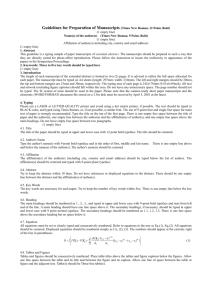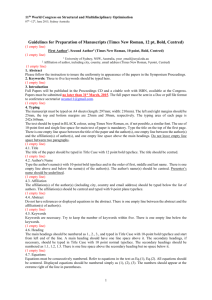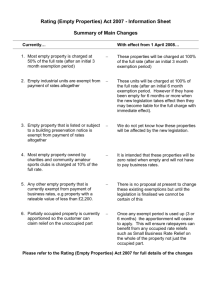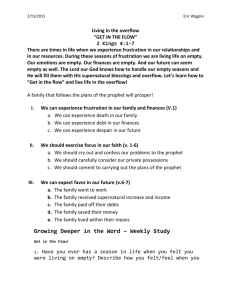Guidelines For The Preparation of Manuscripts
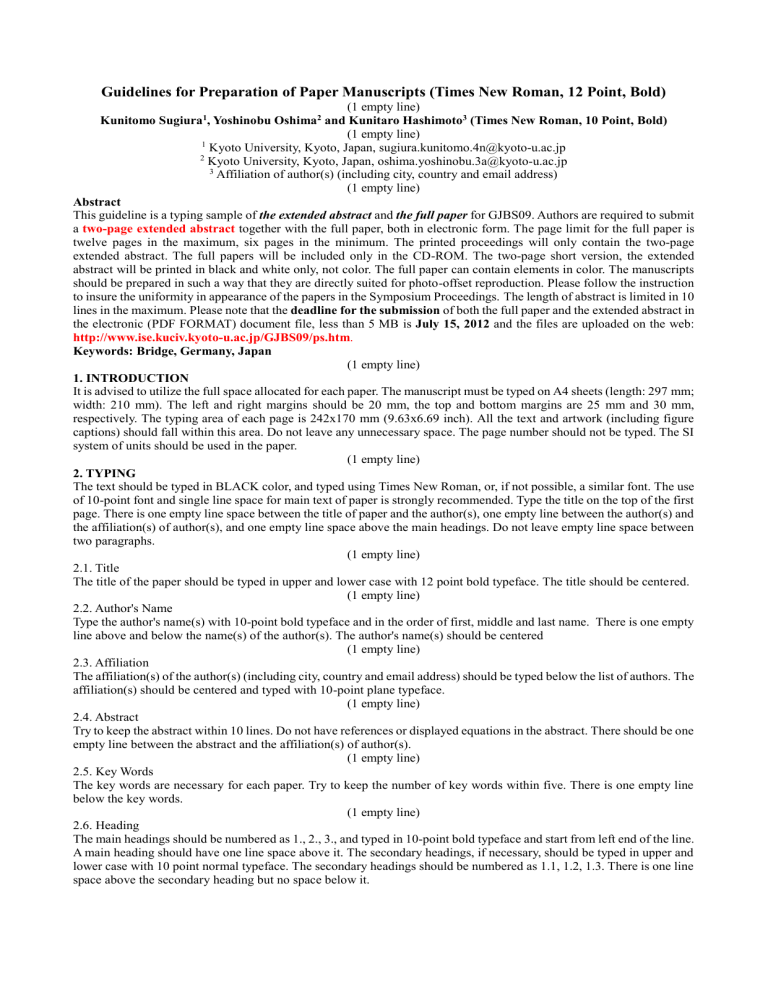
Guidelines for Preparation of Paper Manuscripts (Times New Roman, 12 Point, Bold)
(1 empty line)
Kunitomo Sugiura 1 , Yoshinobu Oshima 2 and Kunitaro Hashimoto 3 (Times New Roman, 10 Point, Bold)
(1 empty line)
1 Kyoto University, Kyoto, Japan, sugiura.kunitomo.4n@kyoto-u.ac.jp
2 Kyoto University, Kyoto, Japan, oshima.yoshinobu.3a@kyoto-u.ac.jp
3 Affiliation of author(s) (including city, country and email address)
(1 empty line)
Abstract
This guideline is a typing sample of the extended abstract and the full paper for GJBS09. Authors are required to submit a two-page extended abstract together with the full paper, both in electronic form. The page limit for the full paper is twelve pages in the maximum, six pages in the minimum. The printed proceedings will only contain the two-page extended abstract. The full papers will be included only in the CD-ROM. The two-page short version, the extended abstract will be printed in black and white only, not color. The full paper can contain elements in color. The manuscripts should be prepared in such a way that they are directly suited for photo-offset reproduction. Please follow the instruction to insure the uniformity in appearance of the papers in the Symposium Proceedings.
The length of abstract is limited in 10 lines in the maximum. Please note that the deadline for the submission of both the full paper and the extended abstract in the electronic (PDF FORMAT) document file, less than 5 MB is July 15, 2012 and the files are uploaded on the web: http://www.ise.kuciv.kyoto-u.ac.jp/GJBS09/ps.htm
.
Keywords: Bridge, Germany, Japan
(1 empty line)
1. INTRODUCTION
It is advised to utilize the full space allocated for each paper. The manuscript must be typed on A4 sheets (length: 297 mm; width: 210 mm). The left and right margins should be 20 mm, the top and bottom margins are 25 mm and 30 mm, respectively. The typing area of each page is 242x170 mm (9.63x6.69 inch). All the text and artwork (including figure captions) should fall within this area. Do not leave any unnecessary space. The page number should not be typed. The SI system of units should be used in the paper.
(1 empty line)
2. TYPING
The text should be typed in BLACK color, and typed using Times New Roman, or, if not possible, a similar font. The use of 10-point font and single line space for main text of paper is strongly recommended. Type the title on the top of the first page. There is one empty line space between the title of paper and the author(s), one empty line between the author(s) and the affiliation(s) of author(s), and one empty line space above the main headings. Do not leave empty line space between two paragraphs.
(1 empty line)
2.1. Title
The title of the paper should be typed in upper and lower case with 12 point bold typeface. The title should be centered.
(1 empty line)
2.2. Author's Name
Type the author's name(s) with 10-point bold typeface and in the order of first, middle and last name. There is one empty line above and below the name(s) of the author(s). The author's name(s) should be centered
(1 empty line)
2.3. Affiliation
The affiliation(s) of the author(s) (including city, country and email address) should be typed below the list of authors. The affiliation(s) should be centered and typed with 10-point plane typeface.
(1 empty line)
2.4. Abstract
Try to keep the abstract within 10 lines. Do not have references or displayed equations in the abstract. There should be one empty line between the abstract and the affiliation(s) of author(s).
(1 empty line)
2.5. Key Words
The key words are necessary for each paper. Try to keep the number of key words within five. There is one empty line below the key words.
(1 empty line)
2.6. Heading
The main headings should be numbered as 1., 2., 3., and typed in 10-point bold typeface and start from left end of the line.
A main heading should have one line space above it. The secondary headings, if necessary, should be typed in upper and lower case with 10 point normal typeface. The secondary headings should be numbered as 1.1, 1.2, 1.3. There is one line space above the secondary heading but no space below it.
(1 empty line)
2.7. Equation
All equations must be set or clearly typed and consecutively numbered. Refer to equations in the text as Eq.(1), Eq.(2). All equations should be centered. Displayed equations should be numbered simply as (1), (2), (3). The numbers should appear at the extreme right of the line in parentheses.
f i
0 j d
i j
H
H
k
d
p
(1)
(1 empty line)
2.8. Tables and Figures
All figures and tables must be inserted near the location where they are first described. Provide a Fig. number and caption below each figure or photograph and a Table number and caption above each table. Allow one line of space between the table or figure and the adjacent text.
(1 empty line)
Fig. 1 Deformation of whole bridge at ultimate state
(1 empty line)
Table 1 Average daily fatigue-damage-accumulation q ave
and average daily large traffic volume V ave
Lane Num. Main girder q ave
( (MPa) 3 /day )
V ave
(volume/day) q ave
V ave
(
(MPa) 3 /volume )
A lane
G1
G2
1.55
×
10 6
8.30
×
10 5
3965
390
209
G4 2.55
×
10 6 375
B lane
G5 5.44
× 10 6
(1 empty line)
6790
801
3. REFERENCES
References should be listed in the order in which they appear in the paper and provided with a reference number in square brackets [1]. Prepare an appendix listing all references in referred order according to the following examples. The titles of books, journals and proceedings should be in italics.
(1 empty line)
[1] Fisher J.W., “ Fatigue and Fracture in Steel Bridges ”, John Wiley & Sons, New York, USA., 1984.
[2] Kitada T., Tanaka K., Kano M., Yamano T. and Okada J., “Verbesserte Computerprogramme für die Bemessung von räumlichen Stahlbrückenkonstruktionen und deren Anwendung”, Stahlbau 72, pp. 289-298, 2003.
[3] Tanaka K., Kitada T., Nibu M. and Kano M., “On a computer program, EPASS, to analyze ultimate load carrying capacity of spatial steel bridge structures”, Proceedings of SSRC Annual Technical Session , pp. 357-367, 1993.

